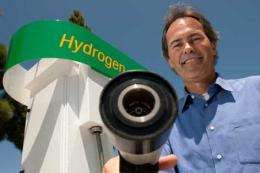Waste not, want not

Imagine being able to get the equivalent of 70 miles per gallon in your car, keep your home cool and power your computer – all from sewage. Thanks to technology developed by UC Irvine’s National Fuel Cell Research Center and partners, that’s now possible.
Ten years of hard work, led by center associate director Jack Brouwer, has paid off in a cutting-edge project at the Orange County Sanitation District in Fountain Valley. A unique fuel cell generator simultaneously and continuously converts gas created in wastewater digesters to hydrogen used for zero-emission vehicle fuel, electricity and heat in a highly efficient manner.
“This will reduce smog and greenhouse gases and mean a better quality of life for Southern Californians,” says Brouwer, showing off the white generator box and shiny silver pipes across from a waste settling pond, along with a brand-new hydrogen fueling station.
Starting this month, drivers of select hydrogen-run cars will be able to exit the 405 freeway at Euclid Avenue and fill up with converted sewage waste. Numerous major automakers have announced plans to commercially manufacture such vehicles by 2015. Using locally produced hydrogen will increase its supply and bring costs in line with other renewable energy sources.
“This is a paradigm shift,” says center director Scott Samuelsen. “We’ll be truly fuel-independent and no longer held hostage by other countries. This is the epitome of sustainability, where we’re taking an endless stream of human waste and transforming it to transportation fuel and electricity. This is the first time this has ever been done.”
At an unveiling of the project Aug. 16, U.S. Rep. Dana Rohrabacher, R-Costa Mesa, and other officials praised the work, calling those behind it “pioneers in the search for clean energy."
Recalling his own childhood in a much smoggier Orange County, Rohrabacher said: “Because the people at the Orange County Sanitation District and UCI’s National Fuel Cell Research Center – whose engineers invented the technology – are doing their duty discovering new sources of clean fuel for the future, our children will have clean air, clean water and a clean environment, even as our communities grow.”
According to Brouwer, a third of all cars on the road in the U.S. could eventually be powered by “biogas,” made from human waste, plant products and other renewable elements.
When waste sits in big, concrete holding tanks, it produces gases, primarily methane, he explains. Most of the methane at Orange County’s sanitation plant is filtered and used for power, with the surplus sold or burned to produce heat. Now that extra methane is being converted to hydrogen on-site by the fuel cell generator.
Fuel cells are like giant batteries. The generator uses chemical catalysts to split hydrogen atoms off each methane molecule. Much of the hydrogen is then transformed into 300 kilowatts of electricity. The rest is siphoned off and piped to the new hydrogen fueling station for use in automobiles equipped with smaller fuel cells, which convert it to electricity to run the engine.
Other collaborators on the project were FuelCell Energy Inc., which makes pollution-free power plants, and Air Products & Chemicals Inc., the biggest global supplier of hydrogen and other industrial gases.
“This location will show how well this technology works,” says Ed Heydorn, Air Products’ business development manager for hydrogen energy systems. “It’s another first for Air Products in terms of the varied sources of feed from which hydrogen can be produced, stored and dispensed.”
There are about 300 hydrogen-fuel cars on the road in California already. They have been leased or sold to an eager group of “early adapters” that includes environmentalists, movie stars, professors and car buffs. The first to pull up to Air Products’ new pump Aug. 16 was Jim Salomon of Newport Beach, in a sleek maroon Honda FCX Clarity he’s been driving for three years.
Despite owning custom muscle machines and other coveted vehicles, he said, “this is my favorite car. People think alternative-fuel cars don’t have guts. This one has great torque.”
Listening to the steady hiss of hydrogen flowing into his tank, Salomon added: “Getting fuel from sewage is even better.”
Provided by University of California, Irvine

















